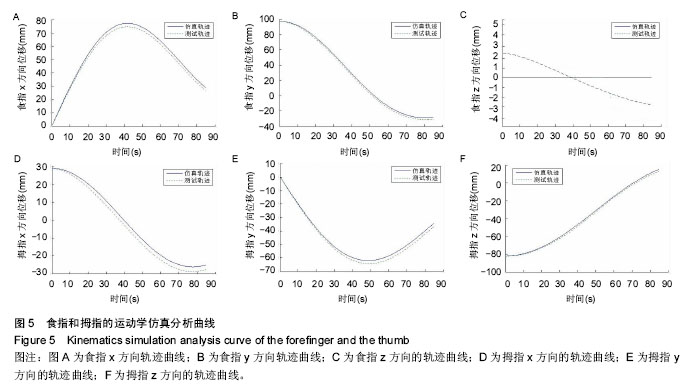| [1] 张冬蕊,耿艳娟,许礼胜,等.虚拟现实手部康复训练系统的设计与实现[J].集成技术,2013,2(4):32-38.[2] 张儒,万军.智能手部康复训练机器人[J].机械与电子, 2008,12:53-55.[3] Sensinger JW,Lock BA,Kuiken TA.Adaptive pattern recognition of myoelectric signal:exploration of conceptual framework and practical algorithms. IEEE Trans Neural Syst Rehabil Eng. 2009;17(3):270-278.[4] Chiri A,Giovavvhini F,Vitiello N,et al.HANDEXOS:towards an exoskeleton device for the rehabilitation of the hand [C].the 2009 IEEE/RSJ International Conference on Intelligent Robots and Systems. USA.2009.[5] Masia L,Krebs HI,Cappa P,et al.Design and characterization of hand module for whole-arm rehabilitation following stroke.Trans Mech. 2007; 12(4):399.[6] 郑若隐,李继婷,王爽,等.一种外骨骼式人手康复机器人的设计[J].中国康复医学杂志,2011,26(8):759-762.[7] 李继才,官龙,胡鑫,等.外骨骼式手功能康复训练器结构设计[J].中国康复理论与实践,2013,19(5):412-415.[8] 张晓玉.伤残辅助器具装配指南[M].北京:中国人事出版社,2006:1-45.[9] 陶泉.手部损伤康复[M].上海:上海交通大学出版社, 2006:1-26.[10] 周俊明,黄锦文,劳杰,等.临床实用手功能康复学[M].北京:世界图书出版公司,2012:52-84.[11] 潘国新,张秀峰,李剑.偏瘫步行康复训练机器人减重支撑系统的研究[J].中国康复医学杂志,2013, 28(11): 1041-1045.[12] 刘畅生,钟龙,刘煦,等.传感器简明手册及应用电路[M].西安:西安电子科技大学出版社,2007:2-66.[13] 牛博真,田恺,张向宇.脑卒中后手功能障碍治疗研究进展[J].针灸临床杂志,2014, 30(1):67-69.[14] 倪俊,张杏梅,顾海峰.烧伤后手指和指蹼挛缩畸形的治疗及功能康复究[J].中国康复医学杂志,2006, 21(8): 693-695.[15] 李友莲,戚晓昆,钱海蓉,等.康复治疗在脑卒中患者上肢及手功能恢复中的应用[J].现代护理,2004, 10(6):67-68.[16] 贾杰.脑卒中后手功能康复应评价和治疗并重[J].上海医药,2014, 35(2):6-9.[17] 黄海,王新庆,姜力,等.欠驱动假手手指抓取力的研究[J].哈尔滨工业大学学报,2010, 42(5):801-805.[18] 史世财,李荣,姜力,等.基于欠驱动原理的5指残疾人假手设计[J].机械制造,2008, 46(528):35-37.[19] 朱健.一种新型欠驱动仿人假肢手的设计与研究[D].上海交通大学,2006.[20] 郑杨,陈垒,王刚,等.欠驱动式手指康复训练装置的结构优化设计[J]. 西安交通大学学报,2015, 49(3):151-156.[21] 马骏,张敏敏,龚晨晓,等.采用三维运动分析的步态康复训练实验装置[J] .微型机与应用,2015,34(12):88-94.[22] 朱孟,艾信友,钟婷婷,等. 偏瘫病人行走康复训练装置的设计[J] .医疗装备,2015,34(12):27-28.[23] 戴金桥,俞阿龙,王爱民,等. 两自由度康复训练交互装置[J]. 测控技术,2015,34(6):59-62.[24] 詹文聪,蒋蓁.一种新型手部康复机器人的设计与研究[J]. 测控技术,2016,43(2):4-7.[25] 赵芳. 软体外骨骼手部康复机器人的研究[D]. 天津理工大学,2016.[26] 李小龙.人体手部康复训练机器人机构的研究与分析[D]. 中北大学,2016.[27] 高宏,刘相权,米洁,等.手部关节康复训练机器人结构设计与运动仿真[J].制造业自动化,2014,36(5):29-31.[28] 高宏,祁志生,盛泰斌,等.手部关节康复训练装置控制系统设计[J] .中国科技信息,2014,12:145-146.[29] 芦英. 手部烧伤康复护理干预的应用意义评估分析 [J] . 中国医药指南,2014,14(1):285-286.[30] 伍翰笙,邓建林,吴霄,等.手部Ⅱ区屈肌腱粘连松解术后早期专科康复治疗疗效观察[J].哈尔滨医药,2016, 36(1): 46-47.[31] 程俊,陈小艳,马婧. 中医手部按摩在骨科手外伤患者康复过程中的疗效探讨[J] .中医药导报,2015, 21(4):60-62.[32] 邹普功; 李长明.手术配合功能康复治疗在手部烧伤挛缩25例中的应用[J] .中国民族民间医药,2015,(9):61-62.[33] 偰冬慧. 基于增强现实的手部康复训练系统的研究[D]. 南京信息工程大学,2015.[34] 刘佳,偰冬慧,陆熊.增强现实技术在人手功能康复中的研究进展[J].中国康复理论与实践,2014,20(2):159-163.[35] 黄珍霞,许乐,李琳,等.手部烧伤患者运动功能临床康复评价方法的研究进展[J].中华护理杂志,2014,49(5): 583-587.[36] 梅钊,何龙文,吴磊,等.便携式外骨骼肘关节康复训练装置的设计及测试[J] .中国康复医学杂志,2015,30(11): 1155-1157.[37] 邢凯,赵新华,陈炜,等.外骨骼机器人的研究现状及发展趋势[J].医疗卫生装备,2015,36(1):104-107.[38] 王源,于海龙,Suzuki Hiroyuki,等.一种基于sEMG评估上肢康复机器人有效性的方法[J].中国数字医学,2013,8(2): 23-26.[39] 肖阳,徐秀林,翟艺,等.基于虚拟现实技术的手功能康复评估训练系统的设计[J].中国康复理论与实践,2016,22(3): 341-344.[40] 张连琼,沈儒霞.高血压脑出血术后护理及早期肢体康复训练[J] .长江大学学报(自科版),2015,12(36):71-73.[41] 李坦东,王收军,侍才洪,等.穿戴式外骨骼机器人的研究现状及趋势[J] .中国康复理论与实践,2016,37(9):116-119.[42] 孙明艳,胡军,刘有海,等.穿戴式下肢外骨骼机器人的结构设计与仿真[J] .机械,2016,43(1):43-48.[43] 李超,袁锐波,丘世因,等. 外骨骼康复机械手的结构设计及仿真分析[J] . 机械与电子,2016,34(2):16-19.[44] House G, Burdea G, Grampurohit N, et al. A feasibility study to determine the benefits of upper extremity virtual rehabilitation therapy for coping with chronic pain post-cancer surgery. Br J Pain. 2016;10(4): 186-197.[45] Kutlu M, Freeman CT, Hallewell E, et al. Upper-limb stroke rehabilitation using electrode-array based functional electrical stimulation with sensing and control innovations. Med Eng Phys. 2016;38(4): 366-379. [46] Tao G, Archambault PS. Powered wheelchair simulator development: implementing combined navigation-reaching tasks with a3D hand motion controller. J Neuroeng Rehabil. 2016;13:3. [47] Weiss P, Heyer L, Munte TF, et al. Towards a parameterizable exoskeleton for training of hand function after stroke. IEEE Int Conf Rehabil Robot. 2013;2013:6650505. [48] Medée B, Bellaiche S, Revol P, et al. Constraint therapy versus intensive training: implications for motor control and brain plasticity after stroke. Neuropsychol Rehabil. 2010;20(6):854-868. |
.jpg)

.jpg)
.jpg)
.jpg)
.jpg)
.jpg)
.jpg)